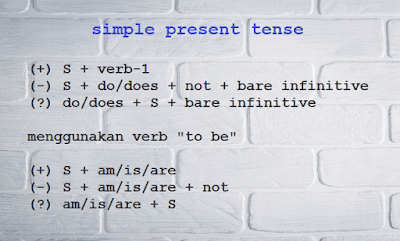Simple Present Tense
The Simple Present Tense is used for a repearted or habitual action.Examples :
1. I go to school every day.
2. I always play basketball on Saturday.
In the two sentences above, we find the both verbs that is in the red word "go and play". In the two sentences telling us the Simple Present Tense in habitual action because I am telling you what I do every day and on Saturday not what I am doing at the present time. So we can use the words : usually, generally, often, always, every day, are used with it.
The Simple Present Tense also used to show a truth or a fact.
Examples :
1. A week has seven days.
2. The sun rises in the east.
How to the Form Simple Present
In the simple present, most regular verbs use
the root form, except in the third-person singular (which ends in -s). For a few verbs, the third-person singular
ends with -es instead
of -s. Typically, these are verbs whose root form ends in o,
ch, sh, th, ss, gh, or z. For most regular verbs, you put the negation
of the verb before the verb, e.g. “She won’t go” or “I don’t smell anything.” So, we can look the picture of simple presnt form to make easy your understanding.
Negative sentences are formed simply by placing "do not" and "does not" in front of the verbs.
Interrogative sentences are formed by placing "do not" and "does not" in front of the subject.
Examples :
Affirmative Negative Interrogative
You go to bed early You do not go to bed early Do you go to bed early?
She studies English She does not studies English Does she studies English?
He drinks coffee He does not drinks coffee Does he drinks coffee?
Affirmative
|
Negative
|
Interrogative
|
I/You/We/They+V1
|
I/You/We/They+
Do not +V1
|
Do+ I/You/We/They+
V1 ?
|
She/He/It+V1
(s,es,ies)
|
She/He/It+Does
not+V1
|
Does not+ She/He/It+V1
?
|





Thanks mba pembahasannya
BalasHapus